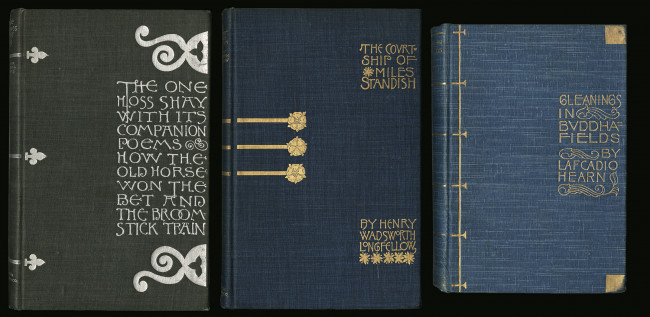
Over the last few decades, the study of material culture has blossomed as a means to explore not only the evolution of specific technologies and their usage but also the histories of women, minorities, tradespeople, and others. Nineteenth century publishers’ bindings can be key to these studies: they are vital to researching the history of the book, the rise of literacy, the impact of technological change, the development of the decorative arts, and more. By the last quarter of the nineteenth century, publishers’ bindings had become (as they remain) marketing tools. These mass-produced objects targeted and attracted consumers while simultaneously broadcasting a distinctive style for the publishing house and its titles. From shop windows, bookstore shelves, and printed advertisements, books’ covers enticed observers to pick them up, to explore their contents, to own them. More than a century later, the allure of these objects still holds.
In addition to the publishers’ bindings found throughout our stacks, Rare Books has a discrete collection of around 1,300 volumes built on the foundational gift of UR alumnus, librarian, bibliophile and scholar Robert F. Metzdorf. During the last year, we have added to our holdings of bindings designed by painter, teacher and stained glass artist Sarah Wyman Whitman (1842-1904). Whitman was a talented, successful artist and prominent figure in Boston’s intellectual, social and cultural circles when, in the early 1880s, she became the primary cover designer for Houghton Mifflin and Company. She is widely recognized as the first female professional artist to hold such a position. Over a 25 year period, Whitman created 250-300 covers, profoundly influencing book design and blazing a path for other women in the field. We share a few of these recently acquired Whitman designs here, with a focus on lesser-known covers. Some of our other Whitman bindings—along with other exemplars—may be seen in our exhibition Beauty for Commerce: Publishers' Bindings, 1830-1910.
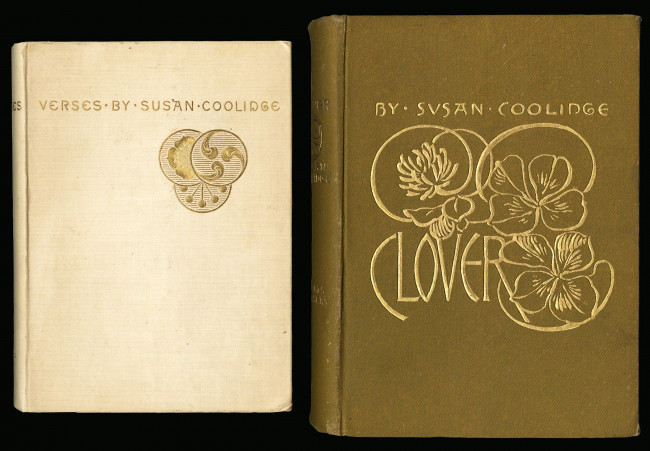
Coolidge, Susan. Clover. Boston: Roberts Brothers, 1889.
Whitman’s first cover was designed in 1880 for Verses by her friend Sarah Chauncey Woolsey who wrote under the penname Susan Coolidge. This design is a clear adaptation of a series of covers (especially Atalanta in Calydon) by pre-Raphaelite painter and designer Dante Gabriel Rossetti in which he used Japanese-style rondels. On Verses, Whitman borrows from Rossetti, but overlaps and moves off-center her rondels, emphasizing her design’s asymmetry and use of negative space. Sent out into a marketplace full of wild, over-crowded book covers, this restrained design, set on daring white cloth, stood out and demanded attention. Whitman’s later and quite different design for Coolidge’s Clover makes subtle visual reference to the cover of Verses. In both cases, as with many of her earliest designs, Whitman introduced elements of the British Aesthetic and Arts and Crafts movements to an American audience.
One of the distinguishing features of Whitman’s work is her lettering, done in two main styles. Her ‘rustic’ alphabet is characterized by the letter “a” surmounted by a bar, a “d” left open at the base, a rounded “e,” and an inwardly spiraling “g”—all drawn rapidly with a quill pen. The letters of her more formal style are drawn against a straight edge and the words are separated by dots. Even when transferred to metal dies and stamped by machine onto countless covers, this lettering, with its deliberate inconsistencies, helped Whitman bring a hand-made aesthetic to mass-produced commercial bindings.
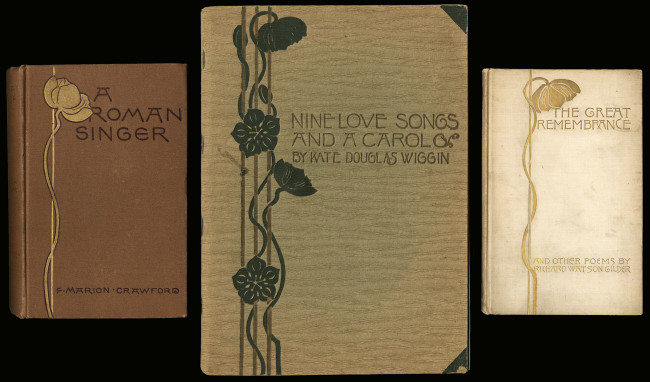
Wiggin, Kate Douglas. Nine Love Songs and A Carol. Boston; New York: Houghton, Mifflin & Co., 1896.
Gilder, Richard Watson. A Great Remembrance. New York: The Century Co., 1893.
Many of Whitman’s covers feature stylized plant forms. Each of the three covers seen above depicts an anemone flower, a bloom she also used for one of her most famous designs, Hawthorne’s The Marble Faun. Business correspondence with George Mifflin reveals Whitman’s involvement in decisions about binding materials and her interest in incorporating atypical textures and colors. The cover of Nine Love Songs and A Carol, seen above, is made of a heavy crepe paper Whitman specifically requested. When preparing some designs, like the two seen below, Whitman sent scraps of dress cloth to the publisher and asked that similar materials be used. It is a testament to her influence at the firm that they agreed.
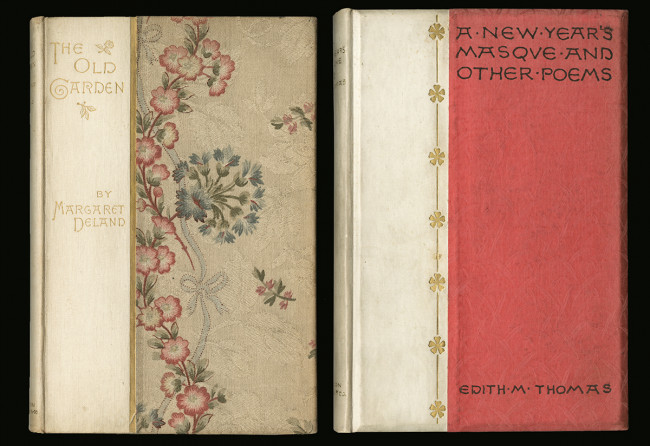
Thomas, Edith M. A New Year's Masque, and Other Poems. Boston; New York: Houghton, Mifflin and Company, 1885.
Whitman’s designs often evoked the physical features of handmade bindings—clasps, corners and sewing supports. Nine Songs, seen above, has stamped ‘tips’ on the outer corners, referencing those sometimes found on leather-bound books. In honoring the traditions of hand binding in her mass-produced covers, she created gestures toward them—“the effect of a clasp, which is not an imitation of the clasp, but an allusion to it…”[1]

Longfellow, Henry Wadsworth. The Courtship of Miles Standish. Boston; New York: Houghton, Mifflin and Company, 1896.
Hearn, Lafcadio. Gleanings in Buddha-Fields. London: Kegan Paul, Trench, Trübner & Co., Limited, [1897?]
Much has been written, and published, about Whitman, her art, social set, and philanthropy that is not repeated here. Her wealth and social status enabled her to pursue her artistic and professional dreams and to overcome barriers many other women could not. Her talent gave her an extraordinary career with simultaneous success as a painter, cover designer and stained glass artist. Whitman’s legacy lives on through her bequests to museums and colleges and is clear in the colored light of her stained glass and the brushstrokes of her paintings. It lives on, too, in her hundreds of book covers, each reproduced in the thousands, each providing a “touch of art.”[2] As proclaimed in an 1894 article, “the pioneer of designing for modern cloth covers is a woman—Mrs. Sarah M Whitman.”[3]
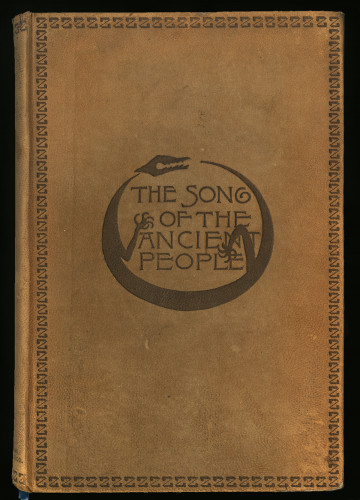
Additional resources on Sarah Wyman Whitman’s life and work
Allen, Sue. The Book Cover Art of Sarah Wyman Whitman. Boston: The Society of Printers, 2012.
Allen, Sue and Gullans, Charles. Decorated Cloth in America: Publisher’s Bindings 1840-1910. UCLA: William Andrews Clark Memorial Library, 1994.
Boston Public Library has a flickrset of over 300 Whitman bindings.
Eckel, Molly. "A Touch of Art": Sarah Wyman Whitman and the Art of the Book in Boston
(2012). Honors Thesis Collection.67.
Smith, Betty S. 2000 "Whitman, Sarah de St. Prix Wyman (1842-1904), designer and fabricator of stained glass, bookcover designer, painter, and writer." American National Biography. 6 Oct. 2018. http://www.anb.org.ezp.lib.rochester.edu/view/10.1093/anb/9780198606697.....
Whitman, Sarah W. The Making of Pictures, Twelve Talks with Young People. Chicago & Boston: The Interstate Publishing Company, 1886.
Whitman, Sarah. Notes on an Informal Talk on Book Illustrations. Boston: Boston Art Studentsʼ Association, 1894.
Footnotes
[1] Whitman, Sarah. Notes on an Informal Talk on Book Illustrations, (Boston: Boston Art Studentsʼ Association, 1894), 8.
[2] Ibid, 5. "…You have got to think how to apply elements of design to these cheaply sold books; to put the touch of art on this thing that is going to be produced at a level price, which allows for no handwork, the decoration to be cut with a die, the books to out by the thousand and to be sold at a low price…"
[3] Commercial Bookbindings: An Historical Sketch, with some Mention of an Exhibition of Drawings, Covers, and Books, at the Grolier Club, April 5 to April 28, 1894, (New York: Grolier Club, 1894), 14.
by: Andrea Reithmayr, Special Collections Librarian for Research & Collections

